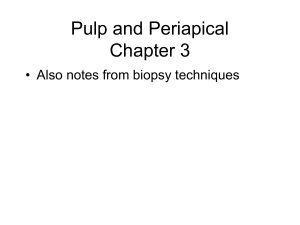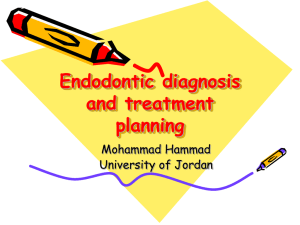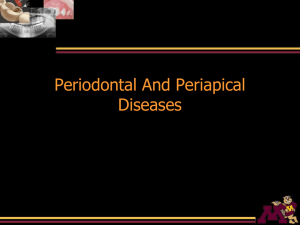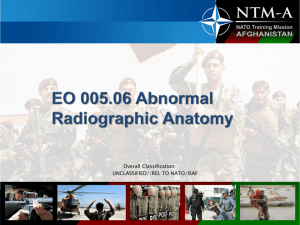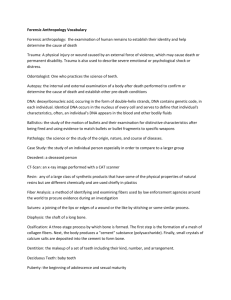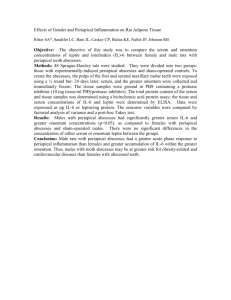Units 2-6
advertisement
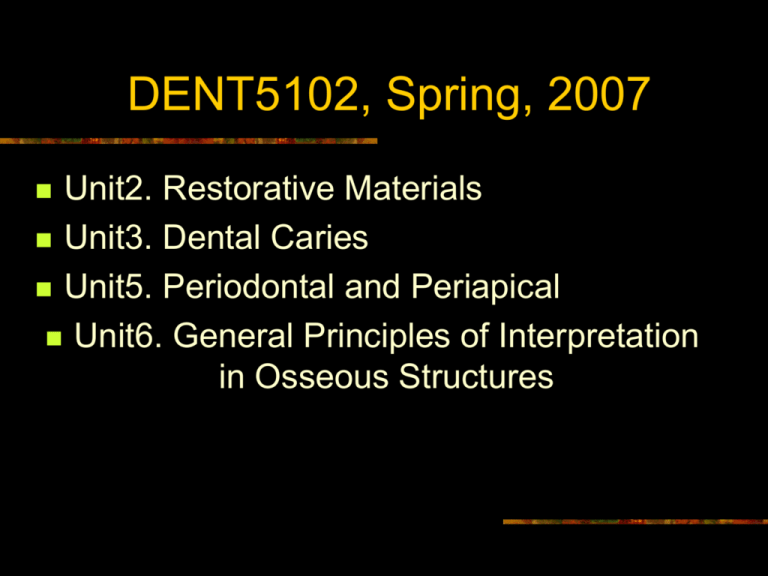
DENT5102, Spring, 2007 Unit2. Restorative Materials Unit3. Dental Caries Unit5. Periodontal and Periapical Unit6. General Principles of Interpretation in Osseous Structures DENT5102 quiz #1 is posted at the following web address: http://www1.umn.edu/dental/courses/dent_5 102/Quiz1/quiz07.html. Restorative Materials According to radiographic density beginning with most radiopaque Group I. Gold alloys, amalgam,silver Gr.II. Gutta percha, zinc oxyphosphate or other base materials, composite with opacifier, rubber base impression material, calcium hydroxide with opacifier Gr.III. Porcelain Restorative Materials (Cont.) Gr. IV. Radiolucent. Calcium hydroxide, composite, resin Dental Caries Severity 1st degree (early, incipient, enamel only) 2nd degree (moderate, to DEJ) 3rd degree (advanced, into dentin) 4th degree (extensive, extending to pulp) Caries Progression Dental Caries (Cont.) Location Occlusal, incisal Lingual, palatal Buccal, facial Proximal (mesial, distal) Cemental (root) Recurrent Dental Caries Most common location for proximal caries: just apical to the contact area.Enamel caries is usually triangular in shape, occasionally rounded. Radiographically, occlusal caries can be seen only when it is in dentin (3rd degree). Incipient Caries Dental Caries (Cont.) Cemental (root) Dental Caries (Cont.) Recurrent Recurrent Caries Caries immediately next to a restoration Inadequate margins or excavation Metallic restorations often hide Clinical examination Dental Caries (Cont.) Adumbrasion (cervical radiolucency, cervical burnout). Adumbration Between CEJ and alveolar crest Diffuse radiolucency Ill-defined borders Presence of the edge of root Clinical evaluation Caries: Xerostomia Therapeutic radiation Sjogren’s syndrome Caries begins at cervical region Extensive decay Periodontal And Periapical Diseases Periodontal Disease Usefulness of Radiographs Amount of bone present Condition of alveolar crest Bone loss in furcation areas Width of periodontal ligament Local factors: calculus, overhanging restorations Crown/root ratio Limitations of Radiographs No indication of morphology of bony defects No indication of successful management No indication of hard/soft tissue relationship, I.e., depth of pockets Normal Alveolar Crest 1.0-1.5 mm apical to cemento-enamel junction Parallel to line joining the CEJ of adjoining teeth Smooth Continuation of lamina dura, has the same radiopacity Severity or Extent of Bone Loss Evidence of Early Periodontitis Localized erosion of crest of bone Blunting of crest- anterior teeth Loss of sharp angle between lamina dura and crest Widening of pdl near crest Local Factors Calculus Overhanging restorations Poor restoration contours Calculus Calculus Overhanging Restoration Buccal VS Lingual Bone Loss Direction Of Bone Loss Horizontal Bone Loss: Crest of bone is parallel to CEJ line between adjoining teeth. The remaining bone is still horizontal but may be positioned apically. Direction Of Bone Loss Vertical bone loss Crest of remaining bone is not parallel to the CEJ line between adjoining teeth ( displays an oblique angulation to the CEJ line ) Bone Loss In Bifurcation/trifurcation Areas Bitewing Radiographs Most Reliable For Crestal Bone Evaluation Generalized Periodontal Disease Juvenile Periodontitis (Early-onset Periodontitis, Rapidly Progressing Periodontitis) Occurs in healthy individuals between puberty and age 25 Amount of bone loss is not consistent with local factors and oral Hygiene habits. Rate of bone loss is 3-4 times faster than in typical periodontitis Juvenile Periodontitis(cont.) Typically affects crestal bone of first molars and incisors. Eventually affects greater # of teeth. Bone loss is progressive and frequently bilaterally symmetrical. Many teeth show vertical bone loss. Host neutrophil dysfunction has been demonstrated by several investigators. Papillon-Lefevre Syndrome Autosomal recessive trait Hyperkeratosis of palms and soles Occasional keratosis of other skin surfaces Calcification in falx cerebri Severe destruction of alveolar bone involving all deciduous and perm. teeth Exfoliation of teeth Langerhans’ Cell Histiocytosis (Histiocytosis X) Complex of three diseases: Eosinophilic granuloma (usually solitary) Hand-Schuller-Christian disease Letterer-Siwe disease Due to abnormal proliferation of Langerhans’ cells or their precursors Eosinophilic Granuloma of Bone Most common in children and young adults Usually single radiolucency Skull, mandible, vertebra and long bones commonly involved Painful, mobile teeth and gingival lesions Hand-Schuller-Christian Disease Most cases reported in children under 10 years. Has been reported in older individuals Skeletal and soft tissues may be involved Classic triad of symptoms: “punched out” destructive bone lesions unilateral or bilateral exophthalmos diabetes insipidus Complete triad occurs in 25% of patients Hand-Schuller-Christian (Cont.) Oral manifestations include: loose teeth exfoliated teeth gingivitis loss of alveolar bone / advanced periodontitis Sharply outlined multiple radiolucent lesions in skull, jaws and other bones Letterer-Siwe Disease Acute, disseminated form of disease Usually occurs before age 3. Most patients die Involves several bones and organs Skin rash Intermittent fever, enlargement of liver and spleen, lymphadenopathy common Destructive radiolucencies in jaws Loosening and premature loss of teeth Hand-Schuller-Christian Disease Hand-Schuller-Christian Disease Other Diseases Influencing Course Of Periodontal Disease Diabetes mellitus Leukemia Periapical Inflamatory Lesions Bone destruction around apex of tooth, mostly secondary to pulp exposure due to caries or trauma. Bacterial invasion of pulp produces toxic metabolites which escape to the periapical bone through apical foramen and cause inflammation. The following may occur: Periapical Inflamatory Lesions Periapical granuloma: Localized mass of chronic granulation tissue containing PMN’s, lymphocytes, plasma cells. Periapical Granuloma Radiographically, widening of PDL or variable size of periapical radiolucency may be present Periapical Granuloma Periapical Granuloma Periapical Abscess Periapical abscess: When pus forms in the area. It may develop directly as an acute process or develop in a preexisting granuloma. Radiographically, appears identical to granuloma. Periapical Granuloma Or Abscess Can one differentiate between the two on the basis of radiographs alone? Periapical Inflamatory Lesions Radicular cyst (periapical cyst): Cell rests of Mallasez (remnants of epithelial root sheath of Hertwig) proliferate due to inflamatory stimulus of a granuloma or an abscess and provide the epithelial lining. What is the definition of a cyst? “A cyst is an epithelium lined cavity which is filled with fluid or semi-solid material”. Radicular cyst is the ONLY cyst related to non-vital pulp. Periapical Inflamatory Lesions Can you definitively differentiate between a periapical granuloma, abscess or radicular cyst on the basis of radiograph alone? Periapical Inflamatory Lesions(co) Condensing osteitis ( chronic sclerosing osteomyelitis or osteitis). Occasionally, the reaction to periapical inflammation is predominantly osteoblastic, I.e., more sclerotic bone is formed (radiopaque mass). This usually occurs in children or young adults when the resistance is high. Most common location is mandibular 1st molar. Condensing Osteitis (Idiopathic) Osteosclerosis Osteosclerosis How do you differentiate between osteosclerosis and condensing osteitis? In osteosclerosis, the pulp is vital. There are no clinical signs or symptoms. No treatment is necessary. Condensing osteitis is secondary to pulp exposure. Patient is symptomatic. Endodontic treatment or extraction is indicated. Calcific Degeneration (Calcific Metamorphosis) Secondary to Trauma to the Tooth Calcific Degeneration Calcific Degeneration Radiographic Evidence Of Non-vital Teeth Widening of apical PDL or periapical radiolucency ( associated with indication of pulp exposure) Discontinuity of lamina dura Displacement of lamina dura Condensing osteitis Calcific degeneration (metamorphosis) Radiographic indication of pulp exposure Radiographic Evidence Of Non-vital Teeth Widening of apical PDL or periapical radiolucency ( associated with indication of pulp exposure) Radiographic Evidence Of Non-vital Teeth Discontinuity lamina dura of Radiographic Evidence Of Non-vital Teeth Displacement of lamina dura Radiographic Evidence Of Non-vital Teeth Condensing osteitis Radiographic Evidence Of Non-vital Teeth Calcific degeneration (metamorphosis) Radiographic Evidence Of Non-vital Teeth Radiographic indication of pulp exposure Periapical Cemental Dysplasia Also called Cementoma. Localized alteration in periapical area. Osseous structure is replaced by fibrous tissue, cementum-like material, abnormal bone or combination of these. Pulp is vital. Patient is asymptomatic. There are no clinical signs. No treatment is required. Mean age is 39 years. Periapical Cemental Dysplasia 85% patients are females. 3 times more common in African-americans. Most commonly seen in mandibular anterior areas. May be multiple. May be bilateral. Well-defined radiolucency, opacity or mixed. Periapical Cemental Dysplasia Stage I ( Osteolytic stage ) Stage II ( Osteo or cementoblastic stage) Stage III ( mature stage ) Stage II Stasge III Multiple Apical Scar (Fibrous Scar ) Variation in healing process. Normally surgical site fills with blood clot which organizes and eventually mineralizes and remodels like surrounding bone. Occasionally, normal mineralization and remodelling fails to occur. Patient is asymptomatic and no treatment is required. Apical Scar (Fibrous Scar ) Apical Scar (Fibrous Scar ) Apical Scar (Fibrous Scar ) Periapical Lesions (Bhaskar) Periapical granuloma 48% Radicular cyst 43% Periapical abscess 1.1% Residual cyst 3.5% Apical scar 3.0% Periapical cemental dysplasia 1.7% Rare lesions 1.0% Rare Periapical Lesions(Bhaskar) Central giant cell granuloma Traumatic (simple) bone cyst Hyperparathyroidism Periapical Lesions (LaLonde and Leubke) Periapical granuloma Radicular cyst Periapical abscess Other periapical lesions 45.2% 43.8% 3.0% 8.0% General Principles of Interpretation in Bone Relative Radiodensity Radiolucency Radiopacity Mixed (radiolucency and radiopacity) Peripheral Outline Borders Well-defined or Illdefined, Smooth or Ragged? Expansion of Cortical Plates Indication of Rate of Growth of Lesion Effects on Adjacent Structures Resorption of roots of teeth Mandibular canal ( pain, anesthesia, paresthesia?) Location Mandible Maxilla Anterior Posterior Multiple-single Age Sex
